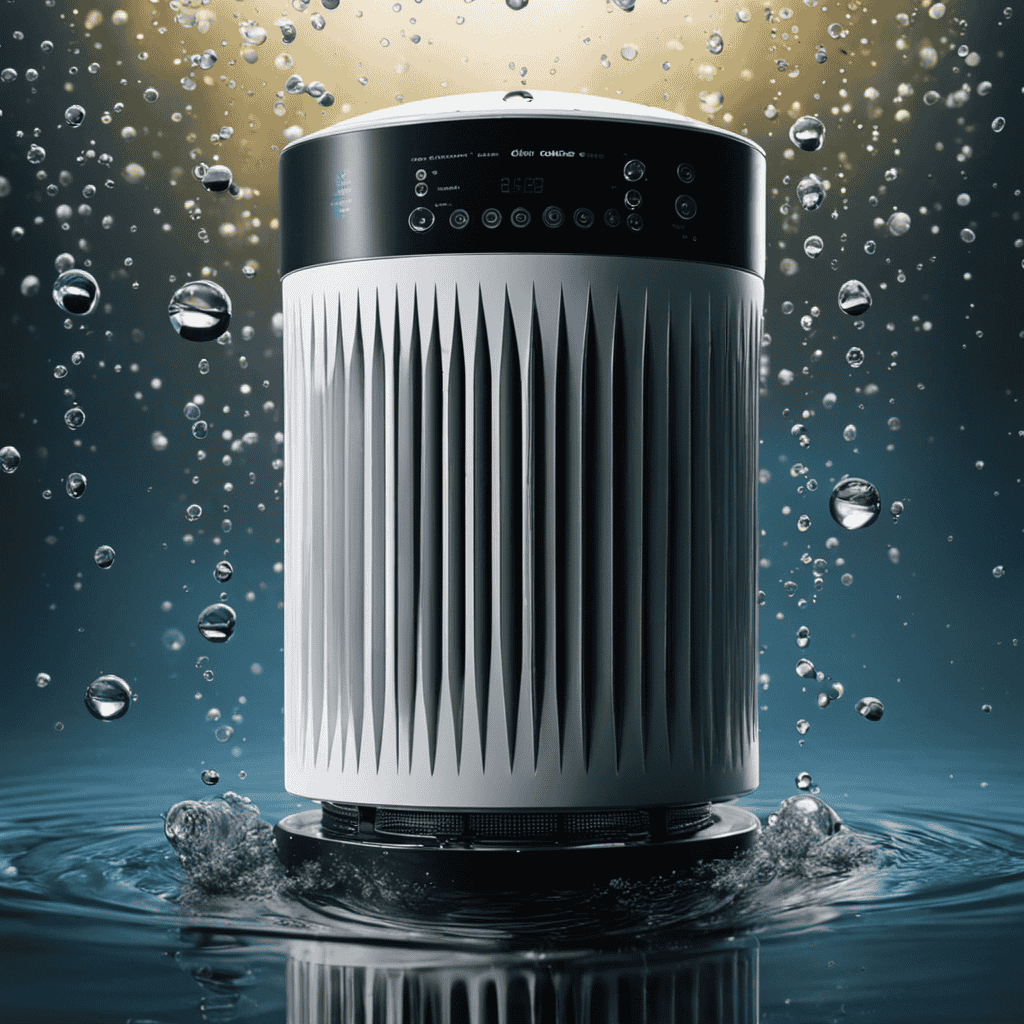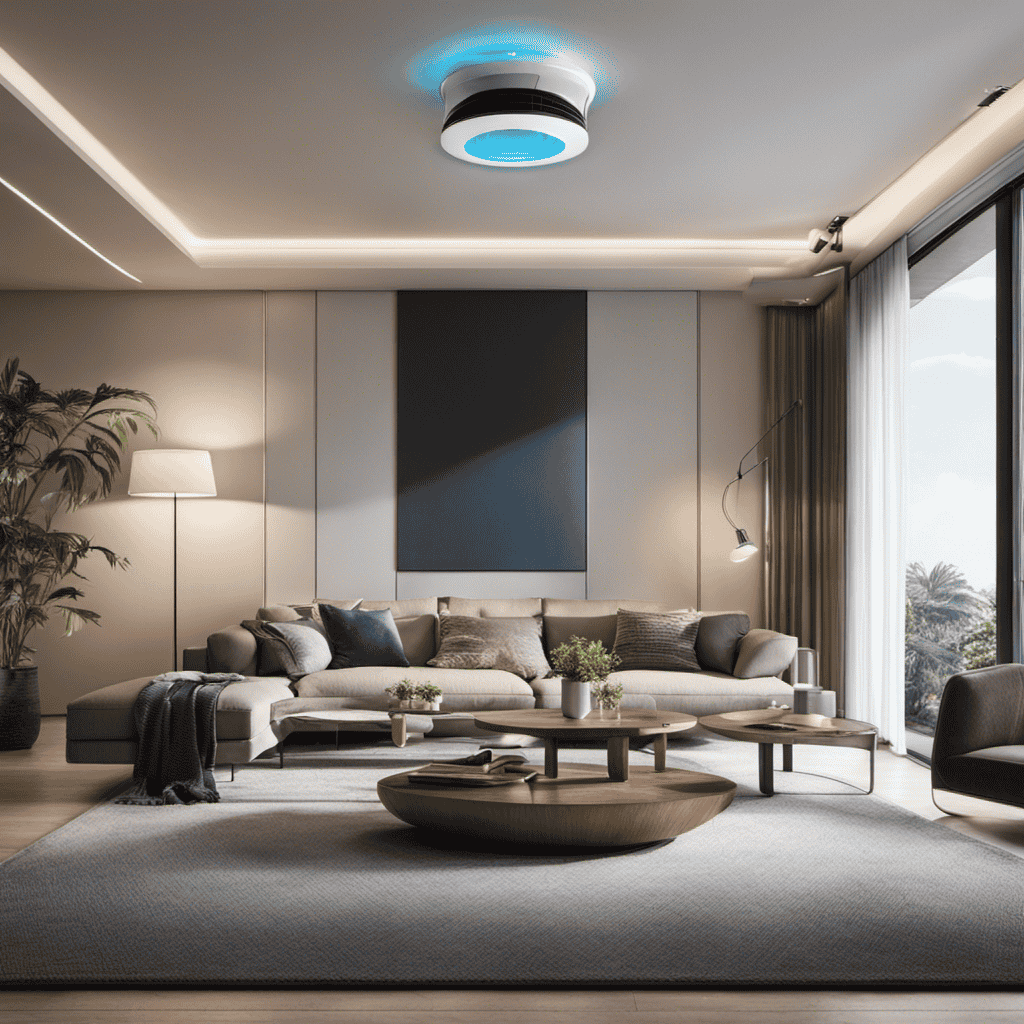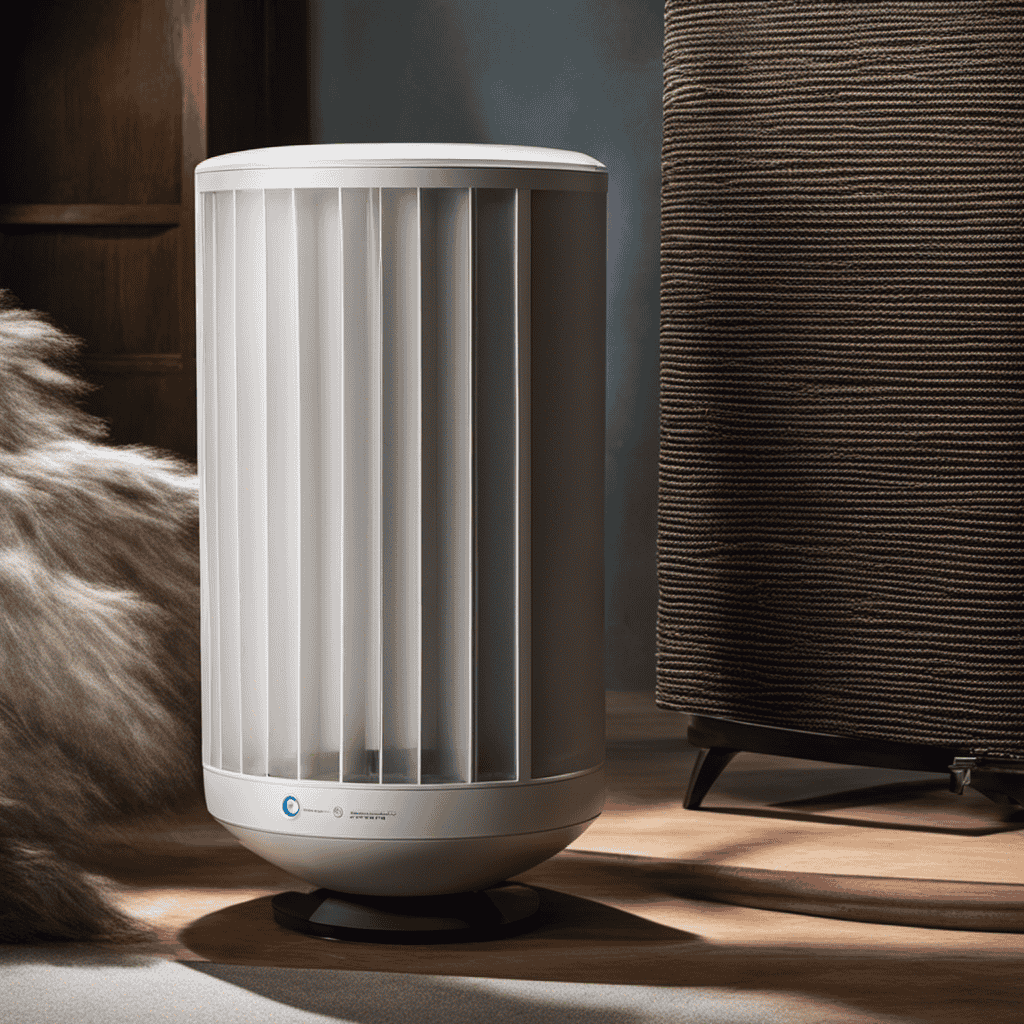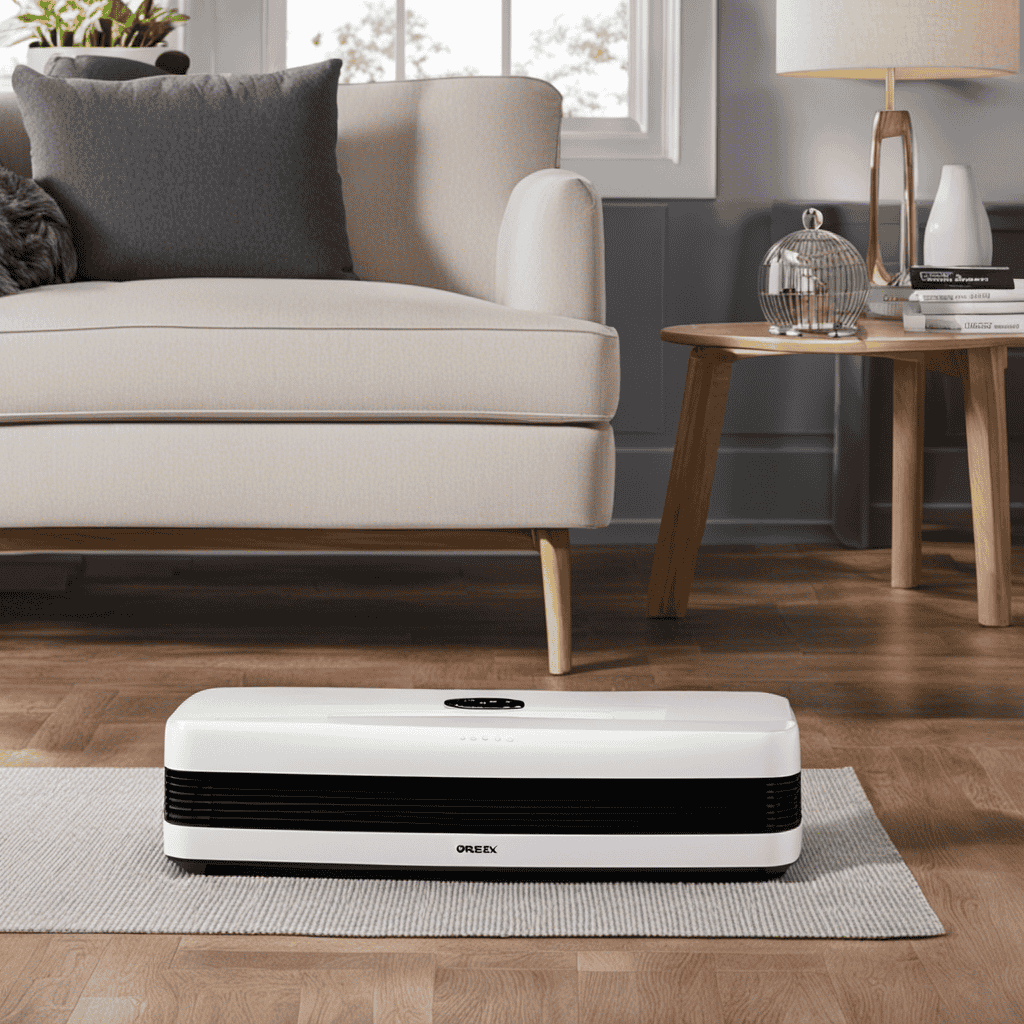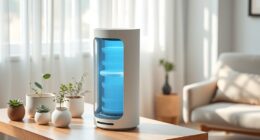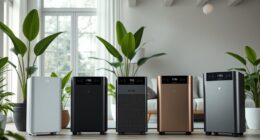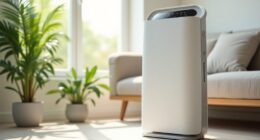Were you aware that water can negatively impact the filters of air purifiers? Indeed, allowing your air purifier filters to become wet may result in possible harm, heightened chances of mold and bacteria proliferation, and reduced effectiveness.
In this article, I will explore the effects of water on air purifier filters and provide steps to take if your filters get wet. By understanding the consequences and taking preventative measures, you can ensure the optimal performance of your air purifier.
Key Takeaways
- Water can cause filters to become moldy and deteriorate, leading to the growth of harmful bacteria and fungi.
- Wet filters are less efficient at trapping pollutants and allergens, reducing overall air quality.
- Mold and bacteria in wet filters can pose health risks, including allergic reactions, respiratory issues, and infections.
- Thoroughly drying wet filters and preventing future moisture are crucial for maintaining filter effectiveness and preventing potential health risks.
The Effects of Water on Air Purifier Filters
Getting water on air purifier filters can cause damage and reduce their effectiveness.
There are several risks of water damage to consider when it comes to air purifier filters. Firstly, water can cause the filters to become moldy, which can lead to the growth of harmful bacteria and fungi. This can have a negative impact on the air quality in your home, as these contaminants can be released into the air when the purifier is turned on.
Additionally, water can cause the filters to deteriorate, making them less efficient at trapping pollutants and allergens. In turn, this can result in a decrease in the overall air quality in your living space.
Therefore, it is important to take precautions to prevent water damage to your air purifier filters and maintain their effectiveness.
Now, let’s explore the potential damage to wet air purifier filters.
Potential Damage to Wet Air Purifier Filters
Be careful not to wet your air purifier filters as it can potentially damage them. Wet filters pose several risks and potential health hazards.
Here are four reasons why you should avoid using wet filters:
-
Reduced efficiency: When water comes into contact with the filter, it can hinder its ability to trap and remove airborne particles effectively. This reduces the overall efficiency of the air purifier.
-
Mold and bacteria growth: Moisture creates an ideal environment for mold and bacteria to thrive. Wet filters provide the perfect breeding ground for these harmful microorganisms, which can be released back into the air and pose health risks.
-
Electrical damage: Water and electricity do not mix well. If water reaches the electrical components of the air purifier through wet filters, it can cause short circuits or even damage the unit beyond repair.
-
Voided warranty: Most air purifier manufacturers explicitly state that using wet filters voids the warranty. This means that if any damage occurs to the unit due to wet filters, you will be responsible for the repair or replacement costs.
To ensure the longevity and effectiveness of your air purifier, it is crucial to keep the filters dry at all times.
Risks of Mold and Bacterial Growth in Wet Filters
Moisture in wet filters creates an ideal environment for mold and bacteria to thrive, posing potential health risks. When filters become wet, whether due to excessive humidity or accidental spills, they become susceptible to contamination. Mold and bacteria can quickly grow and multiply in the damp conditions, leading to a range of health hazards.
Mold spores can cause allergic reactions, respiratory issues, and even infections in individuals with weakened immune systems. Bacteria, on the other hand, can cause infections, particularly in the respiratory system. The risks of filter contamination should not be taken lightly, as the presence of mold and bacteria in the air we breathe can have detrimental effects on our health.
Regular maintenance and prompt replacement of wet filters are crucial in order to prevent the growth of mold and bacteria and minimize the associated health risks.
Decreased Efficiency and Performance of Wet Filters
The decreased efficiency and performance of wet filters can result in poor air quality and potential health risks. When air purifier filters get wet, their ability to effectively capture and remove pollutants from the air diminishes. This can have a negative impact on the indoor air quality, allowing harmful particles to circulate and potentially causing respiratory issues or allergies.
Here are four key ways in which wet filters can compromise air quality:
-
Reduced filtration capacity: Wet filters become less effective at trapping airborne particles, allowing them to freely circulate in the air.
-
Increased mold and bacteria growth: Moisture provides an ideal breeding ground for mold and bacteria, which can further contaminate the air.
-
Clogged filters: Wet filters are prone to clogging, which restricts airflow and decreases the overall performance of the air purifier.
-
Decreased lifespan: Moisture can cause damage to the filter material, reducing its longevity and requiring more frequent replacements.
With the potential risks of wet filters on air quality in mind, it’s important to take immediate steps to address the issue and prevent further complications.
Steps to Take if Your Air Purifier Filters Get Wet
If you accidentally get your air purifier filters wet, there are a few important steps you should take to restore their efficiency and prevent further damage.
First, you’ll need to thoroughly dry the filters before putting them back in the air purifier. This can be done by placing them in a well-ventilated area and allowing them to air dry completely.
If the filters have been severely water damaged and cannot be restored, it is crucial to replace them with new ones to ensure optimal performance.
Lastly, to prevent filter moisture in the future, it is recommended to avoid exposing the filters to excessive humidity or water sources and regularly inspect and clean the air purifier to prevent any potential water leakage.
Drying Wet Air Filters
Drying wet air filters can help restore their effectiveness and improve air quality. When your air purifier filters get wet, it is important to take the necessary steps to dry them properly. Here are four drying techniques to consider:
- Remove the wet filters from the air purifier and gently pat them dry with a clean towel.
- Place the filters in a well-ventilated area and allow them to air dry completely. Avoid using heat sources, as they may damage the filters.
- Use a fan to speed up the drying process. Position the fan in front of the filters to promote air circulation.
- Consider using a dehumidifier in the room to reduce moisture levels and aid in the drying process.
Properly drying wet air filters can prevent mold and mildew growth, ensuring the long-term effectiveness of the filters and maintaining good air quality in your home. However, in some cases, water damage may be too severe, and it may be necessary to replace the filters.
Replacing Water-Damaged Filters
Replacing water-damaged filters is essential for maintaining optimal air quality in your home. When filters become wet, they can become a breeding ground for mold, bacteria, and other harmful contaminants. These pollutants can then be released into the air you breathe, leading to potential health issues.
To avoid this, it is important to replace damaged filters as soon as possible. By doing so, you can prevent the spread of harmful particles and ensure that your air purifier continues to effectively remove pollutants from your home.
Additionally, regularly replacing damaged filters can also help extend the lifespan of your air purifier. By maintaining clean and dry filters, you can maximize the efficiency and effectiveness of your air purification system.
Preventing Filter Moisture
To prevent moisture from damaging your air purifier filters, it’s important to take proactive measures such as regular maintenance and keeping humidity levels in check. Moisture can lead to condensation, which can seep into the filters and compromise their effectiveness.
Here are four moisture control strategies to help prevent condensation and keep your air purifier filters in optimal condition:
-
Monitor humidity levels: Use a hygrometer to measure the humidity in your home. Ideally, the humidity should be between 30-50%. If it exceeds this range, consider using a dehumidifier to reduce moisture levels.
-
Proper ventilation: Ensure that your home has proper ventilation to allow for adequate air circulation. Open windows or use exhaust fans to remove excess moisture from the air.
-
Regular cleaning: Clean your air purifier regularly to prevent dust and debris buildup, which can trap moisture and lead to condensation on the filters.
-
Avoid placing near water sources: Keep your air purifier away from areas with high moisture levels, such as kitchens and bathrooms, to minimize the risk of water damage to the filters.
Preventing Water Damage to Air Purifier Filters
When it comes to preventing water damage to air purifier filters, there are a few key points to consider.
First, it’s important to explore waterproof filter options, which can provide an extra layer of protection against moisture.
Additionally, knowing how to properly clean water-damaged filters and practicing regular filter maintenance can help ensure the longevity and effectiveness of your air purifier system.
Waterproof Filter Options
If you’re looking for waterproof filter options, consider checking out models that are specifically designed for moisture resistance. These filters offer several benefits over traditional options:
-
Enhanced durability: Waterproof filters are built to withstand exposure to moisture, making them more resistant to damage and extending their lifespan.
-
Improved air quality: These filters effectively remove pollutants and allergens from the air, ensuring a cleaner and healthier environment.
-
Easy maintenance: Waterproof filters are typically washable and reusable, allowing for convenient cleaning and maintenance.
-
Versatility: These filters can be used in various settings, including bathrooms, kitchens, and outdoor spaces, without worrying about moisture damage.
When it comes to alternative filter options, waterproof filters offer a reliable and efficient solution for maintaining air quality while protecting against water damage.
Consider investing in these filters to enjoy their numerous benefits and peace of mind.
Cleaning Water-Damaged Filters
After water damage, it’s important to thoroughly clean your wet air purifier filters to prevent mold and maintain optimal performance. Cleaning water-damaged filters requires specific techniques and drying methods to ensure they are properly restored.
Firstly, gently remove the filters from the air purifier unit and inspect them for any visible debris or mold growth. Use a soft brush or vacuum cleaner to remove the dirt and dust particles.
Next, rinse the filters with clean water to eliminate any remaining contaminants. Avoid using harsh chemicals or detergents as they can damage the filters.
Once cleaned, allow the filters to air dry completely before reinstalling them in the air purifier. This may take several hours or even overnight, depending on the humidity levels.
Ensuring thorough cleaning and proper drying methods will help maintain the effectiveness and longevity of your air purifier filters.
Proper Filter Maintenance
To properly maintain your filters, it’s essential to regularly clean and inspect them for debris or mold growth. Neglecting filter maintenance can result in reduced air purifier performance and potentially harmful indoor air quality.
Here are four important steps for proper filter maintenance:
-
Regular cleaning: Depending on usage, filters should be cleaned every one to three months. Use a soft brush or vacuum to remove dust and debris from the surface of the filter.
-
Proper drying techniques: After cleaning, allow the filter to dry completely before reinserting it into the air purifier. Avoid using heat sources to speed up the drying process, as excessive heat can damage the filter material.
-
Filter replacement: Over time, filters become less effective at capturing pollutants. It’s important to replace filters according to the manufacturer’s recommendations to ensure optimal performance.
-
Inspect for mold growth: Check filters regularly for signs of mold or mildew. If mold is present, it’s best to replace the filter immediately to prevent the spread of airborne contaminants.
Frequently Asked Questions
Can I Use My Air Purifier if the Filters Get Wet?
If my air purifier filters get wet, I shouldn’t use the device until they are completely dry. Wet filters can lead to reduced performance and potential damage to the air purifier. It’s important to follow proper air purifier maintenance and troubleshoot any problems promptly.
How Long Does It Take for Mold or Bacteria to Grow on Wet Air Purifier Filters?
When air purifier filters become wet, mold or bacteria can start growing within hours. This can cause damage to the air purifier and compromise its effectiveness in cleaning the air.
Can Wet Air Purifier Filters Be Repaired or Do I Need to Replace Them?
If my air purifier filters get wet, I need to replace them. Repairing wet filters is not recommended. Regular maintenance of air purifier filters is beneficial for optimal performance and cleaner air quality.
Are There Any Health Risks Associated With Using Air Purifier Filters That Have Gotten Wet?
Using wet air purifier filters can pose health risks as they may promote mold and bacterial growth. To prevent this, avoid getting filters wet by keeping them away from moisture sources and regularly checking for leaks.
Is There a Way to Dry Air Purifier Filters at Home, or Should I Seek Professional Help?
If my air purifier filters get wet, I should first turn off the device and unplug it. Then, I can try drying the filters at home using a gentle method like air drying or using a fan. If that doesn’t work, I may need to seek professional help.
Conclusion
In conclusion, getting your air purifier filters wet can have detrimental effects on their performance and longevity.
Just like a delicate flower wilting in a rainstorm, wet filters can become damaged, leading to decreased efficiency and potential mold or bacterial growth.
It is important to take immediate action if your filters get wet, such as drying them thoroughly or replacing them if necessary.
By preventing water damage in the first place, you can ensure that your air purifier continues to work effectively in providing clean and fresh air.
